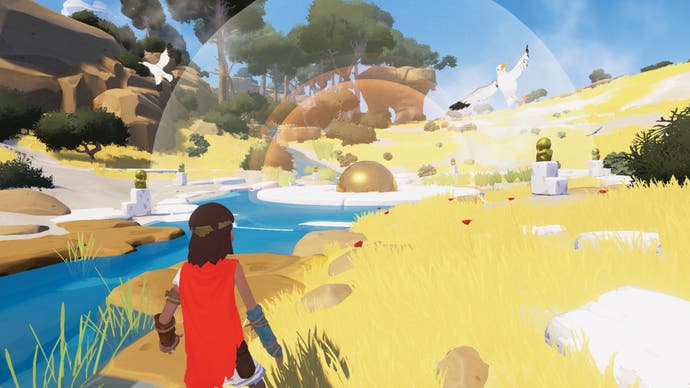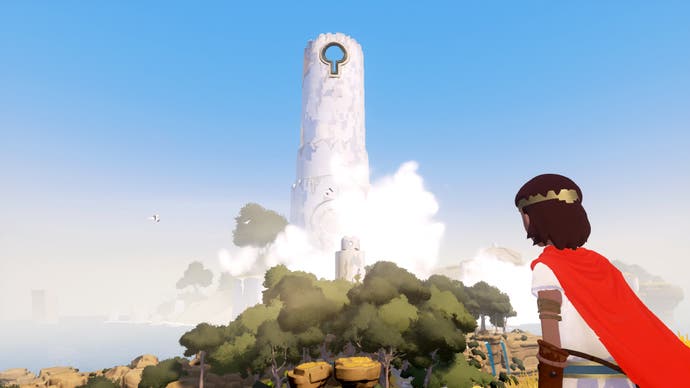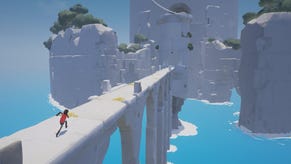The joy of Rime and the petrification of indie gaming
ICOnic.
Rime has seen more than its fair share of reversals: an open world platform-puzzler from Tequila Works set on a deserted tropical island, it was originally pitched as an Xbox One exclusive, then scooped up as one of PS4's headline indie titles, only to be cast adrift a couple of years later. Save for a slightly rocky frame-rate on Xbox One, however, it's shaping up rather well. As the game begins, your character, a mop-headed youth in rags, awakens on a balmy shore studded with enormous marble ruins. Wandering along the beach past milling gulls and fretful crabs, you discover an inlet leading to a wooded dell. At its centre, the curiously lifelike statue of a fox.
By clambering up and calling out to smaller statues, dotted across the coast, you can free bolts of energy that coruscate down to the fox, eventually transforming it into a flesh-and-blood animal who opens the way to the island's interior. The act of racing these dancing, ephemeral fireworks back to the statue could be Rime in a nutshell - serene yet boisterous, a game that is as much about the delight of inhabiting a particular body in a particular place as it is achievement or discovery.

Arcane secrets await deeper within the island - puzzles built upon perspective, a gigantic winged predator and a mechanism that, seemingly, allows you to change the time of day. Much as I'm eager to play on, though, my mind keeps sliding off the game. There's a strangely piecemeal, bolted-together quality to Rime, for all the fluid, organically weathered curves of its shrines and hillsides - it's a little too easy to pigeon-hole, to break down into sets of parallels and influences. The ocean is pure Wind Waker, contorted by creamy white breakers that beg you to plunge in. The island's terrain feels like a nod to the acclaimed Myst-a-like The Witness, the clean architecture of its puzzles buried amid impressionistic blobs of foliage and gentle yet irresistible light-shadow contrasts. The boy's movements evoke Ico, all flying knees and elbows accentuated by a flapping red cape, while the dynamic orchestral score puts me in mind of Ori and the Blind Forest, Microsoft's 2015 indie starlet - plangent tinkles of piano, soaring strings and a wordless female solo.
I'm not, to be clear, trying to suggest that Tequila Works has ripped any of these games off. Rime's aesthetic apparently owes as much to the painters Giorgio de Chirico and Joaquin Sorolla as the likes of Journey, and in any case, there's nothing wrong with wearing your influences on your sleeve, providing you make the most of them. But I do think Rime encapsulates and makes visible a problem that characterises all of the aforementioned titles, to varying degrees - the idea that "indie" refers neither to a developer's financial circumstances nor some aspirational creative ethos, but a concrete genre made up of certain themes, mechanics and visual cues.
An indie game can be anything, of course, but when we talk about "indie" games today, I think we're actually talking about something quite specific - a blend of colourful nostalgia, psychological or emotive depth, and limited mechanical innovation. The game will be either a platform-puzzler that unfolds in some fading pastoral idyll, or an overclocked, splattery arcade shooter set in the 1980s (or a near-future made up to resemble the 1980s). It will seek to capture the feel and tempo of a beloved classic, but with a distinctively "modern" twist involving, say, real-time physics or procedural generation.
It will probably facilitate (or claim to facilitate) a heartfelt investigation of the human condition, an inner journey of some sort. It may also be a pixel-art game, or look a bit like Minecraft. It will make a show of lacking "polish", of being designed with more regard for vision and authenticity than craft, but much of the time, that rough-and-readiness will have been painstakingly styled - think ostentatious pixellation or lo-fi, "painterly" textureless surfaces or objects. Above all else, it will take itself very seriously. Thus the broad stereotype foisted on us by dozens of E3 showcase reels, storefront artworks, various individual success stories and, it must be admitted, the gaming press.

I don't have a problem with any of these qualities in themselves - strolling through the surf in Rime certainly makes a nice break from a stodgy, pseudo-realistic content 'em up like Ghost Recon: Wildlands - but I do have a problem with the idea that "indie" is any particular kind of thing, a species of game that can be identified at a glance. Where once the term might have implied the unexpected, the provocative, nowadays it primes us for what is essentially retro entertainment invested with an over-compensatory sincerity that acts as an implicit reproof to criticism. It reflects the continual co-opting of marginal creators by the so-called mainstream, the pressure to soften "underground" or "outsider" art into a form that can be easily replicated and thus, converted into profit, and which then drowns out anything that doesn't fit the bill.
I've enjoyed my time with Rime, and I'm looking forward to discovering what lurks further within the island, but at the time of writing it is representative of this co-option - from its Zelda-ish play of puzzles and exploration through its underlying coming-of-age narrative to its wistful bucolic vistas. The game has been seized on as a quintessentially "indie" work, featured prominently by Microsoft and Sony's self-publishing programmes, and is an elegant, mesmerising production thus far, but also one that sings a familiar tune. It's not enough for independent games to charm us with their earnestness or fidelity to the classics - we should require them to shock and challenge us in the bargain, if "indie" is to be more than an effigy set in stone.










